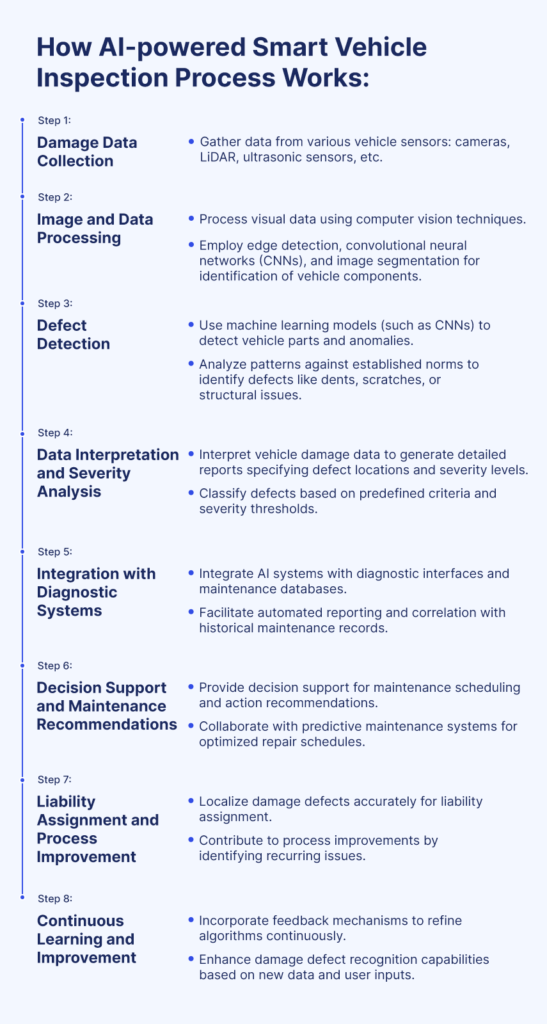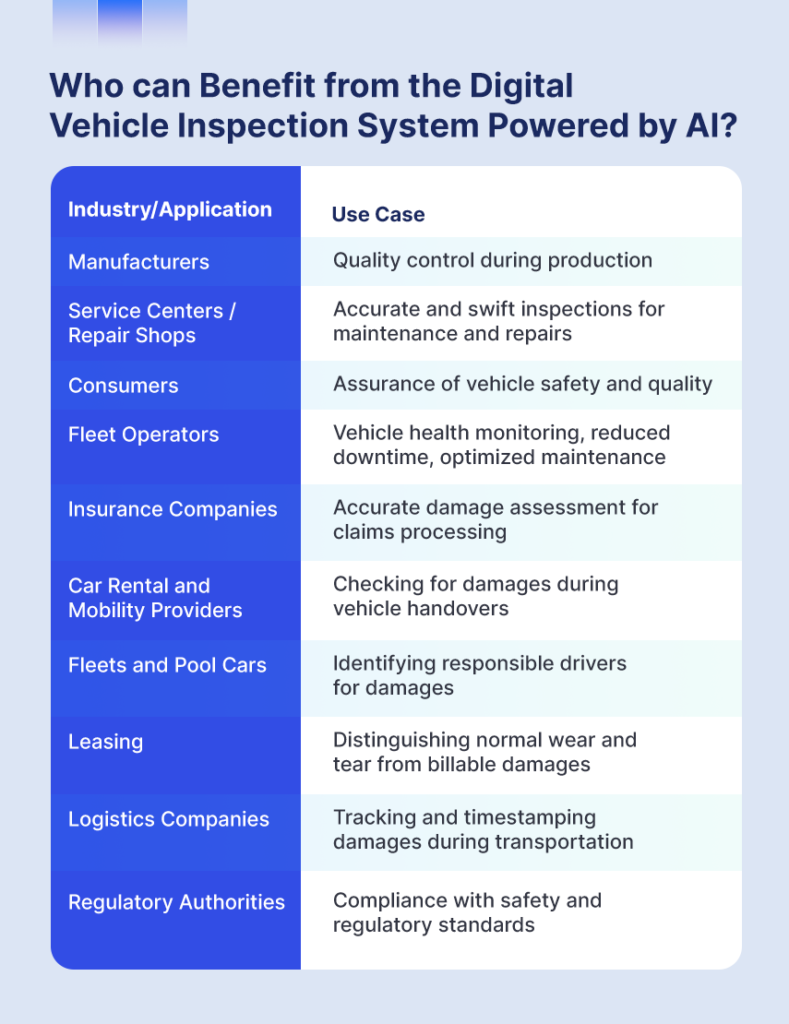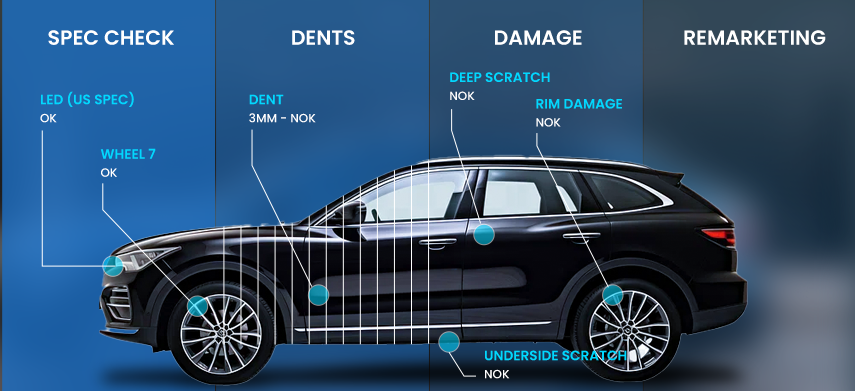AI is making waves in every industry and the automotive industry is no exception, undergoing a radical transformation in the way vehicles are inspected for damages and safety all around the world.
The outdated traditional methods, often reliant on manual checks for scratches, dents, and other damages, are time-consuming and subject to human error. The advent of AI has transformed this damage detection process by introducing advanced automated systems equipped with cutting-edge algorithms that can detect damage with remarkable precision.
We uncovered AI's capabilities in 'Vehicle Number Plate Detection’ in our previous blog. Today, we will explore how AI transforms vehicle inspections in detail. In this blog, we'll delve into the role of AI in damage detection, real-world AI use cases, how the automated vehicle inspection process works, benefits, and more.
Integration of AI in Vehicle Inspections
AI-powered systems are trained to recognize and analyze various patterns and anomalies in vehicle structures, surfaces, and components. Inspections transcend human limitations in this entire damage detection process.
AI in vehicle inspections can swiftly identify minute defects that might have been missed, misjudged, or once impossible through the human eye. Often, minor damages, if left undetected, can escalate into major safety hazards. AI's precision in identifying these issues early on contributes significantly to preventing accidents and prolonging the lifespan of vehicles.
From dents to structural weaknesses, smart inspection systems meticulously scan and evaluate vehicle components. Vehicles undergo comprehensive automated assessments with increased precision, speed, and objectivity.
Such smart automotive inspections use advanced machine learning algorithms and computer vision technology to scan every part of a vehicle and generate a thorough 360-degree visual evaluation report of the vehicle's condition. Let’s take a look at those state-of-the-art AI technologies.
AI Technologies Used in Digital Vehicle Inspection
AI technology optimizes and assures accurate damage detection through a combination of advanced technologies that have made automated vehicle inspection feasible.
Computer Vision:
AI-enabled systems use computer vision algorithms to "see" and interpret images or video data captured during vehicle inspections. It employs image processing techniques to interpret visual data from cameras or sensors installed on inspection devices. These algorithms analyze the visual elements and identify patterns, shapes, damages, and anomalies.
Machine Learning Models:
These ML models are trained on vast datasets containing images of vehicles with various types of damages and normal conditions. Through this training, AI learns to recognize and differentiate between different types of vehicle damage accurately.
Feature Extraction:
AI algorithms extract specific features from the visual data, such as scratches, marks, paint irregularities, or structural damage. These features are analyzed and compared against learned patterns to identify deviations indicating potential damage.
Deep Learning:
A subset of machine learning, deep learning involves neural networks that mimic human brain functions. This allows for more intricate analysis of complex visual data and improves the accuracy of damage detection.
IoT & Sensor Technology:
Advanced sensors and IoT-enabled diagnostic tools automate the inspection process and provide data for external vehicle damages and internal components. They can quickly identify and report any issues in vehicles, equipping mechanics and inspectors with the vehicle's health and performance data.
Data Analytics and Big Data:
AI systems leverage data analytics and big data processing capabilities to handle and analyze vast amounts of inspection data. Analyzing this data using algorithms can predict potential failures, detect patterns, and optimize maintenance schedules. This proactive approach enhances safety and reduces inspection time.
Such technologies converge to power AI-driven digital vehicle inspection processes, paving the way for a proactive approach to vehicle maintenance and safety in the automotive industry. Now, let's see how the digital vehicle inspection system works.

The limitations and shortcomings of traditional inspection methods create a compelling case for the adoption of AI-driven technologies, which promise to address vehicle inspection issues comprehensively. Let's now take a look at some real-world examples.
AI in Vehicle Inspections: Real-world Use Cases for Damage Detection
There are numerous ways to apply AI to automobile inspection, including identifying the kind of damage, determining whether it can be repaired or not, and estimating the cost and time of repair. Here are some of the AI use cases tailored for the vehicle inspection process:
Automated Visual Inspection:
An AI-powered computer vision system can analyze images and videos of vehicles to identify defects, damages, or irregularities in real-time. This includes assessing the condition of the paint, identifying dents, scratches, or other physical damages, and detecting component wear and tear.
Predictive Maintenance:
AI algorithms can predict potential issues by interpreting historical data and real-time sensor readings from a fleet and different vehicles. This farsighted approach allows for timely maintenance, reducing the chances of mechanical breakdowns and improving overall vehicle safety and longevity.
Pattern Recognition:
Machine learning models are trained on vast datasets of vehicle damages and normal conditions, enabling them to recognize and classify various types of internal and external damages.
Documentation and Record-Keeping:
AI can help in managing vehicle maintenance records, vehicle inspection forms, and other documentation efficiently. It automates data entry, organizes service histories, and facilitates easy access to information, improving the overall inspection process.
Anomaly Detection:
AI-powered systems can detect anomalies in vehicles, alerting technicians to potential vehicle issues that might not be easily noticeable. This early detection prevents minor issues from escalating into major problems.
Vehicle Safety Inspection:
AI-based algorithms can analyze various parts of vehicles, including airbag functionality, brake systems, and adherence to safety regulations. Such AI-powered safety features ensure that vehicles comply with safety standards, enhancing road safety for drivers and passengers.
Data Analysis and Decision Support:
AI algorithms can process vast amounts of data collected from vehicle inspections, providing valuable insights through a detailed vehicle inspection report to manufacturers, service centers, vehicle inspection stations, and automobile experts. This data-driven approach helps in making smart decisions regarding maintenance, design improvements, and customer service.
Parts Inventory Management:
AI analyzes usage patterns and predicts the demand for replacement parts. This is helpful in maintaining optimal inventory levels for any service center or automobile business. In addition, the technology assists in reducing excess stock while ensuring necessary parts are readily available when needed.
Remote Diagnostics and Assistance:
AI-powered diagnostic tools can remotely assess vehicle issues, providing guidance to technicians and allowing for faster and more accurate repairs. This is particularly useful in situations where physical access to the vehicle might be limited.
Fleet Management and Monitoring:
AI helps manage fleets by monitoring vehicle health, driver behavior, and route optimization, improving efficiency and reducing operational costs. By collecting and analyzing data from various sensors and telematics devices, AI assists in predicting maintenance needs, optimizing routes to improve fuel efficiency, and monitoring driver performance for enhanced safety and operational efficiency.
Quality Control in Vehicle Manufacturing:
AI-enabled systems can monitor the production line of automobile manufacturers, ensuring that vehicles meet quality standards and a vehicle inspection checklist during the manufacturing process. This includes detecting faults in parts, any mechanical issues, verifying assembly accuracy, and maintaining consistency in production quality.
Self Vehicle Inspection for Insurance Claims
AI can facilitate self-vehicle inspections, which can transform the claim process. By empowering vehicle owners to capture and submit damage data using AI-driven applications, it expedites assessments. Data submitted to AI algorithms are quickly analyzed, identified and categorized accurately according to predefined criteria, eliminating human error and ensuring fair claims settlements.
Thus, AI-driven digital vehicle inspection systems conduct rapid, accurate, and comprehensive assessments of vehicles, reshaping the inspection and maintenance processes.

By harnessing these AI capabilities, vehicle inspections undergo a remarkable transformation, evolving from labor-intensive and potentially error-prone processes into streamlined, accurate assessments. Let us delve into the tangible benefits derived from AI-driven damage detection.
Benefits of AI-Powered Damage Detection in Automated Vehicle Inspection
Here are the benefits of AI-powered damage detection in the vehicle inspection process:
Improved Accuracy, Consistency and Reliability:
An AI-driven digital vehicle inspection system offers unparalleled precision in detecting damages by identifying even minor issues that might go unnoticed in traditional inspections. It ensures consistent evaluation standards across the process and provides reliable and uniform assessments regardless of the inspector.
Data-Driven Insights:
The collected inspection data enables analysis for predictive maintenance. By analyzing this extensive dataset, AI identifies recurring patterns in damages, empowering proactive measures to optimize maintenance schedules. This proactive approach minimizes downtime, ensuring vehicles are in optimal condition more frequently. Consequently, it significantly enhances vehicle longevity, ultimately contributing to more reliable and durable vehicles on the road.
Enhanced Safety Standards:
Early detection of damages due to AI-powered inspections significantly contributes to enhanced safety standards. By ensuring vehicles are consistently maintained in optimal condition, these inspections play a pivotal role in mitigating potential hazards that might arise from undetected issues. This assertive approach not only fosters safer roads but also minimizes the risks associated with vehicle malfunctions or unnoticed damages, ultimately prioritizing the safety of drivers, passengers, and pedestrians alike.
Streamlined Processes:
The integration of AI brings about streamlined processes in vehicle inspections, chiefly through workflow automation. AI-powered systems automate the entire inspection process, and therefore manual efforts are significantly reduced, optimizing overall operational efficiency. This automation doesn't just save time and effort; it also ensures a smoother, more cohesive inspection process.
Cost-Effectiveness and Time Efficiency:
The implementation of AI in the vehicle inspection process identifies damages swiftly, preventing further deterioration, and the risk of major, costly repairs. It minimizes the need for extensive manual labor and skilled inspectors. Furthermore, automation through AI expedites the vehicle inspection process by significantly reducing the time required for assessments, and damage detection, while maintaining high accuracy, leading to faster turnaround times.
Customer Satisfaction:
AI systems revolutionize customer satisfaction by delivering thorough and precise vehicle inspections, instilling unparalleled confidence in the condition of both purchased and serviced vehicles. This heightened confidence translates directly into elevated levels of satisfaction and trust among customers. This enhanced satisfaction becomes a cornerstone in establishing long-term relationships and fostering a positive reputation within the automotive industry.
Reduction in Human Error and Subjective Judgment:
AI-driven inspections drastically reduce human error and subjective judgment by ensuring objectivity through predefined parameters. These algorithms meticulously evaluate damages, enhancing consistency and reliability across all inspections. This standardized approach guarantees more reliable results and provides minute damage detection information. It empowers decision-makers with comprehensive reports for decision-making in maintenance, repairs, or further assessments.
Consequently, AI-powered damage detection upgrades the vehicle inspection process, enhancing efficiency and accuracy at every stage This integration significantly impacts cost optimization, safety enhancement, and operational effectiveness in the automotive industry.
Challenges of AI-powered Vehicle Inspection System
When it comes to using AI for the vehicle inspection process, there are only 5 concerns as of now for most automotive businesses:
- Data privacy is a potential issue.
- AI automation raises job displacement concerns as the manual process keeps a lot of people involved in the process. What about their jobs?
- Financially, installing complex AI machinery at dealerships might strain budgets, potentially affecting business and patronage. Lack of infrastructure and procurement costs are the main concern for automobile businesses.
- Early AI stages might have limited datasets and technical challenges, including high storage costs and environmental impacts due to energy consumption.
- Inherent biases in AI may affect initial inspection results until noticed and rectified.
The Future Trends of Vehicle Inspection
The capabilities of AI are mind blowing and will evolve further with IoT integration in automobiles and other emerging technology integration. One of the most promising prospects lies in the extensive deployment of AI throughout the entire vehicle logistics chain. This transformation will redefine how inspections are conducted, automating processes from the heart of production facilities to the final handovers at dealerships. The result? A landscape where manual inspections become obsolete, replaced by AI-driven precision.
This digitization isn't just about adopting new technologies; it’s about fundamentally reshaping how we understand a vehicle's journey. Envision a digital vehicle passport, an intricate record documenting a vehicle's condition throughout its lifecycle. This innovation facilitates accurate liability assignments and opens the door for significant process improvements and cost reduction across the entire supply chain.
Moreover, this shift towards automation doesn't eliminate human inspectors; instead, it liberates their expertise for higher-value tasks, significantly enhancing operational efficiency.
The future is anticipated to be dominated by automotive AI applications and smart solutions, leading us toward a tomorrow where a basic smartphone camera becomes the primary tool for conducting inspections. Consequently, it could empower vehicle owners to conduct and submit inspections independently, revolutionizing the inspection landscape.
This impending reality is one that many automotive organizations are actively investing in. Notably, automotive giants like Toyota and Ford are already using AI technology to have industry-leading automated vehicle inspection and drive substantial business benefits. The automotive artificial intelligence market, expected to reach a staggering $15.9 billion by 2027, is witnessing phenomenal growth driven by escalating demand for AI-based services catering to various automotive needs.
So, the future of vehicle inspection is a paradigm shift set to redefine the entire industry, marking a new era in automotive excellence driven by the boundless capabilities of AI.
Conclusion
The integration of AI in vehicle inspections signifies a groundbreaking advancement, promising unparalleled accuracy, efficiency, and safety on the road. It is set to revolutionize the way we drive, with advancements in autonomous systems, digital tools, road safety innovations, and smart mobility solutions. This technological leap is here to revolutionize the inspection process, standing as a guardian of safer journeys for all road users and contributing significantly to AI-enhanced road safety standards.
Partnering with a trusted AI development company is key to harnessing the power of AI seamlessly into your automobile business operations. Connect with us to explore how our artificial intelligence services can optimize your vehicle inspection process, enhance accuracy, and drive innovation in the automotive sector.





 January 12, 2024
January 12, 2024


